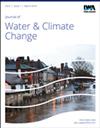Random forest and support vector machine classifiers for coastal wetland characterization using the combination of features derived from optical data and synthetic aperture radar dataset
IF 3.1
4区 环境科学与生态学
Q2 WATER RESOURCES
引用次数: 0
Abstract
Mapping mangrove forests is crucial for their conservation, but it is challenging due to their complex characteristics. Many studies have explored machine learning techniques that use Synthetic Aperture Radar (SAR) and optical data to improve wetland classification. This research compares the random forest (RF) and support vector machine (SVM) algorithms, employing Sentinel-1 dual polarimetric C-band data and Sentinel-2 optical data for mapping mangrove forests. The study also incorporates various derived parameters. The Jeffries–Matusita distance and Spearman’s rank correlation are used to evaluate the significance of commonly used spectral indices and SAR parameters in wetland classification. Only significant parameters are retained, reducing data dimensionality from 63 initial features to 23–33 essential features, resulting in an 18% improvement in classification accuracy. The combination of SAR and optical data yields a substantial 33% increase in the overall accuracy for both SVM and RF classification. Consistently, the fusion of SAR and optical data produces higher classification accuracy in both RF and SVM algorithms. This research provides an effective approach for monitoring changes in Pichavaram wetlands and offers a valuable framework for future wetland monitoring, supporting the planning and sustainable management of this critical area.利用从光学数据和合成孔径雷达数据集获得的特征组合使用随机森林和支持向量机分类器进行沿岸湿地特征描述
绘制红树林地图对保护红树林至关重要,但由于红树林的复杂特性,绘制红树林地图极具挑战性。许多研究探索了使用合成孔径雷达(SAR)和光学数据来改进湿地分类的机器学习技术。本研究比较了随机森林 (RF) 算法和支持向量机 (SVM) 算法,采用哨兵-1 双偏振 C 波段数据和哨兵-2 光学数据绘制红树林地图。研究还纳入了各种衍生参数。Jeffries-Matusita 距离和 Spearman 等级相关性用于评估常用光谱指数和合成孔径雷达参数在湿地分类中的重要性。只保留重要参数,将数据维度从 63 个初始特征减少到 23-33 个基本特征,从而将分类准确率提高了 18%。结合合成孔径雷达和光学数据,SVM 和 RF 分类的总体准确率大幅提高了 33%。SAR和光学数据的融合在RF和SVM算法中都产生了更高的分类精度。这项研究为监测 Pichavaram 湿地的变化提供了一种有效的方法,并为未来的湿地监测提供了一个宝贵的框架,为这一重要区域的规划和可持续管理提供了支持。
本文章由计算机程序翻译,如有差异,请以英文原文为准。
求助全文
约1分钟内获得全文
求助全文
来源期刊

Journal of Water and Climate Change
WATER RESOURCES-
CiteScore
4.80
自引率
10.70%
发文量
168
审稿时长
>12 weeks
期刊介绍:
Journal of Water and Climate Change publishes refereed research and practitioner papers on all aspects of water science, technology, management and innovation in response to climate change, with emphasis on reduction of energy usage.
 求助内容:
求助内容: 应助结果提醒方式:
应助结果提醒方式:


